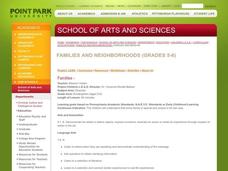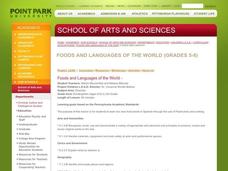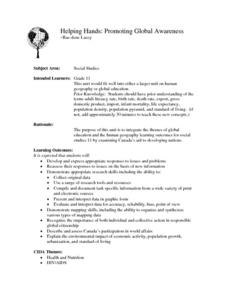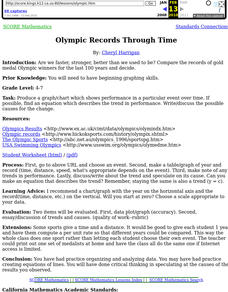Curated OER
The 1828 Campaign of Andrew Jackson: Issues in the Election of 1828 and Beyond
Students research the campaign and election issues of Andrew Jackson. In this presidential election lesson, students research the campaign of 1828. Students then list the important issues. Students discuss the political advertisements in...
Curated OER
Families
Students draw a picture of their families and discuss how each is different. In this families lesson plan, students discuss how each family is uniquely different and special in their own way.
Curated OER
Foods and Languages of the World
Students review Mexico's location and language and learn to pronouns 10 new Spanish food words. Students listen as the book, Corn is Maize is read, touching and passing around an ear of Indian corn. Students discuss the contribution of...
Curated OER
Understanding Cloud Formation
Young scholars read and relate the poem, "Clouds" by Aileen Fisher to a demonstration on cloud formation. They create clouds in jars using ice water and matches then discuss the ways clouds can be used to predict weather.
Curated OER
Helping Hands: Promoting Gloval Awareness
Eleventh graders explore Canadian support for foreign aide. In groups, 11th graders discuss Canadian aide policies and express their opinion of each. Students brainstorm methods of contributing to developing nations. They complete...
Curated OER
TE Lesson: Caught in the Net
Learners student the concept of bycatch, the act of unintentionally catching certain living creatures using fishing equipment. They determine the difference between bycatch and target creatures. They discover what species become bycatch...
Curated OER
Technology: Rating Inventions
Third graders brainstorm a list of inventions used daily. They use Kidspiration to create a web with inventions in the middle. Students choose three inventions from the web and rank them according to interest.
Curated OER
Olympic records through time
Students compare the records of gold medal Olympic winners for the last 100 years and decide if we are faster, stronger than in the past.
Curated OER
Native American Poetry
Fourth graders locate the poetry section of the LMC. They produce a hand written transparency based on the poem Hiawatha by Henry Wadsworth Longfellow. Students illustrate a poem from their poetry section. It is a mystery to them what...
Curated OER
Do You See What I See?
Students observe and describe different objects seen under a microscope and compare the individual perspectives of what was seen.
Curated OER
Oink, Moo, Peep What Is A Farm?
Learners explore the workings of a farm. After reading "Charlotte's Web," students visit a farm. They discuss their observations of the real farm to the one described in the book. Learners create a map of the farm they visited. They...
Curated OER
"Graph It"
Students work in teams to conduct short surveys of their classmates. They show their results using at least two different types of graphs.
Students separate into teams and are asked that each team to choose something that they are...
Curated OER
Comparing Ethnic Groups
Eleventh graders explore the relationship between the United States and the Native Americans from after the Civil War to the early 1900's. They evaluate the actions of the United States towards Native Americans and compare the actions to...
Curated OER
Using The Catalog to Locate Information
Fourth graders identify prior knowledge of the Public Access Catalog. They identify parts of a catalog record. Students use the Public Access Catalog to locate an item. The teacher place 6-8 books on the tables. Students locate several...















